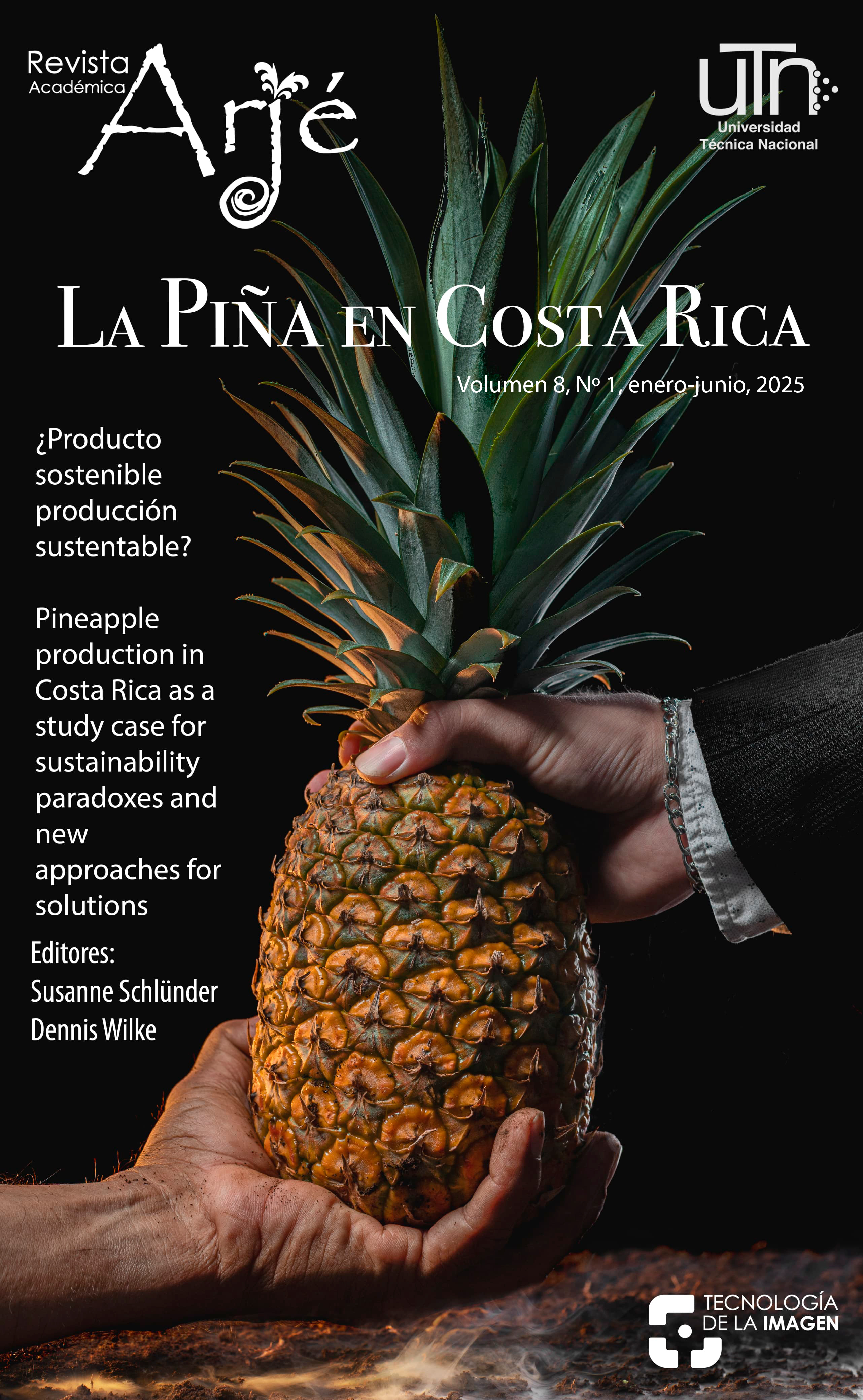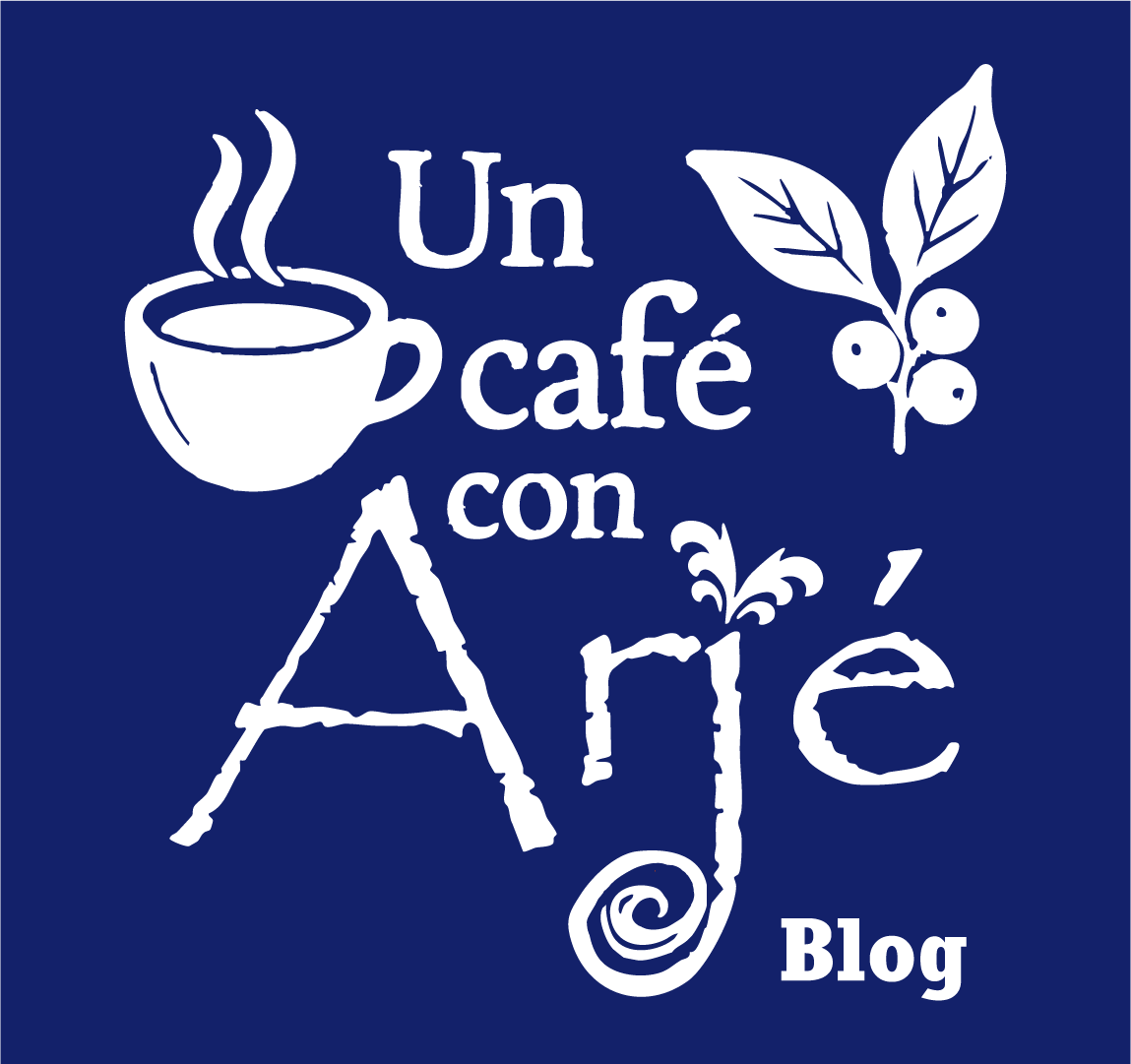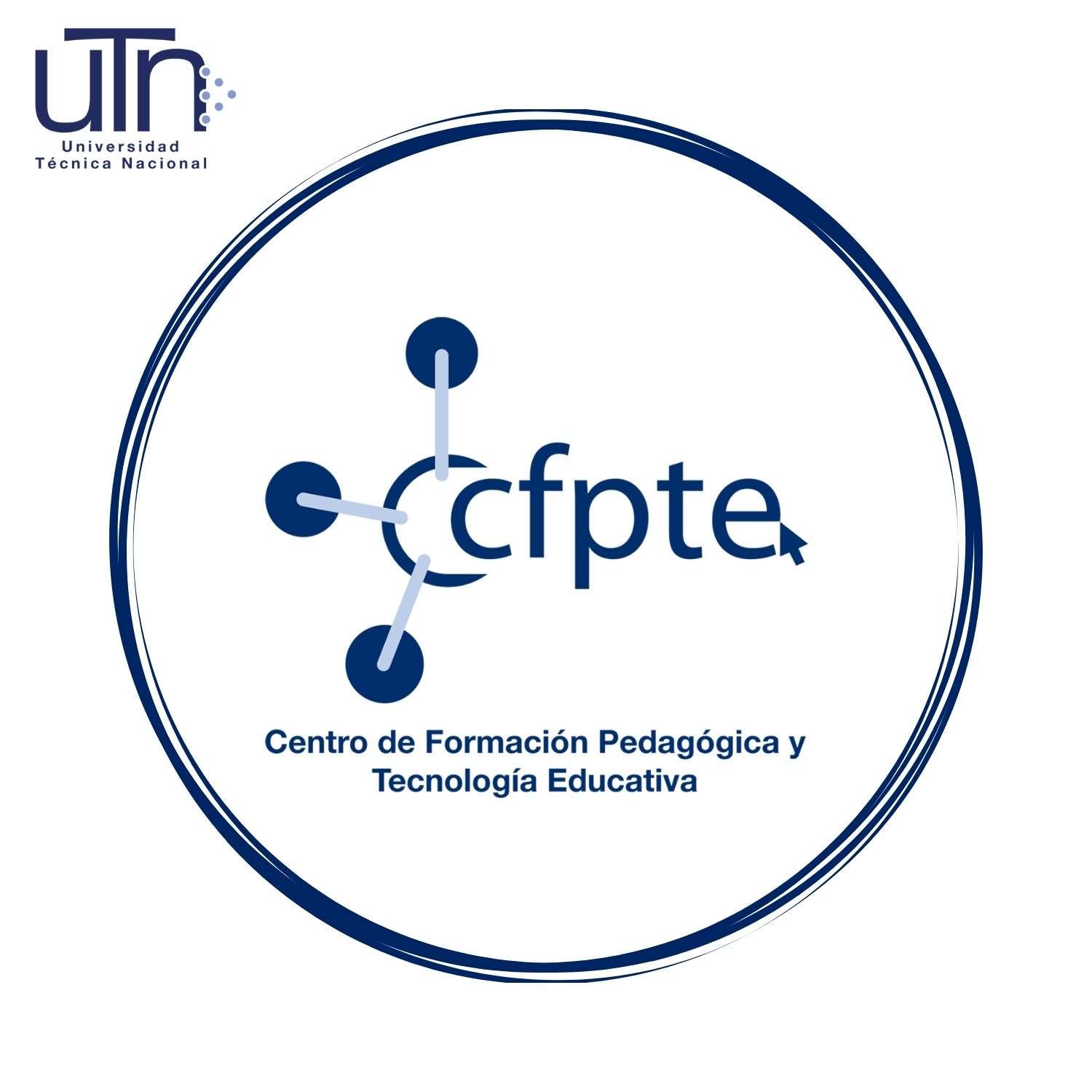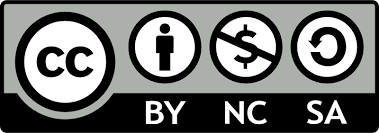Agrochemicals in Costa Rica’s pineapple industry: A review of environmental and human health impacts
DOI:
https://doi.org/10.47633/29p6qn27Keywords:
Contamination, Environmental Impact, Human Health, Pesticides, Pineapple CultivationAbstract
This article focuses on the environmental and human health impacts of agrochemicals used in the production of pineapples (Ananas comosus) in Costa Rica. The pineapple production process involves several stages from cultivation to packing. Different types of inputs, such as agrochemicals, machinery, fuels, electricity, and water are known to be used along this production process. While the climate impacts and solid agricultural waste management of pineapple production in Costa Rica have recently been studied, the environmental and human health impacts of agrochemicals in the production process remain underexplored. We address this gap by reviewing articles and reports from academic databases, scientific journals, government reports, and reputable organizations. The review is organized around the key themes of pesticide residue contamination, environmental impact, human health implications, and societal response. It identifies risks to non-target organisms, ecosystems, and human health from pineapple production across different regions in Costa Rica. The findings are discussed in the context of other pineapple-producing countries globally to highlight potential leverage points to make pineapple production in Costa Rica more sustainable and support human health. Hereby, this study provides an up-to-date insightful analysis of the implications of chemical pollution in Costa Rican pineapple production industry. The findings underscore the importance of adopting more sustainable practices to mitigate environmental and health risks associated with this economically crucial agricultural industry. Moreover, a better understanding of the complex dynamics between agricultural practices, environmental sustainability, and public health is imperative to develop and implement adequate policy measures. As of now, there is insufficient systematic data and knowledge on the application of chemical substances along the pineapple production chain, which has to be addressed in the near future.
Downloads
References
Acuña-Alvarado, M., & Álvarez, M. (2019, febrero 5). Situación laboral y ambiental de las piñeras en la Zona Norte. Semanario Universidad. https://web.archive.org/web/20240706160659/https://semanariouniversidad.com/opinion/situacion-laboral-y-ambiental-de-las-pineras-en-la-zona-norte/
Adriano-Anaya, L., Pardo-Girón, L. F., Salvador-Adriano, M., Salvador-Figueroa, M., Ovando-Medina, I., & Moreno-Castillo, B. (2024). Effectiveness of Bacillus subtilis ANT01 and Rhizobium sp. 11B on the control of fusarium wilt in pineapple (Ananas comosus). PeerJ, 12, e16871. https://doi.org/10.7717/peerj.16871
Alavanja, M. C. R., Hoppin, J. A., & Kamel, F. (2004). Health Effects of Chronic Pesticide Exposure: Cancer and Neurotoxicity. Annual Review of Public Health, 25(1), 155–197. https://doi.org/10.1146/annurev.publhealth.25.101802.123020
Ammann, L., Doppler, T., Stamm, C., Reichert, P., & Fenicia, F. (2020). Characterizing fast herbicide transport in a small agricultural catchment with conceptual models. Journal of Hydrology, 586, 124812. https://doi.org/10.1016/j.jhydrol.2020.124812
Amores-Monge, V., Goyanes, S., Ribba, L., Lopretti, M., Sandoval-Barrantes, M., Camacho, M., Corrales-Ureña, Y., & Vega-Baudrit, J. R. (2022). Pineapple Agro-Industrial Biomass to Produce Biomedical Applications in a Circular Economy Context in Costa Rica. Polymers, 14(22), 4864. https://doi.org/10.3390/polym14224864
Arias-Andrés, M., Rämö, R., Mena Torres, F., Ugalde, R., Grandas, L., Ruepert, C., Castillo, L. E., Van Den Brink, P. J., & Gunnarsson, J. S. (2018). Lower tier toxicity risk assessment of agriculture pesticides detected on the Río Madre de Dios watershed, Costa Rica. Environmental Science and Pollution Research, 25(14), 13312–13321. https://doi.org/10.1007/s11356-016-7875-7
Aristoteles, P. M., Sanches, N. F., Teixeira, F. A., & Simão, A. H. (2011). Pineapple integrated pest management - an overview. Acta Horticulturae, 902, 339–347. https://doi.org/10.17660/ActaHortic.2011.902.38
Artavia-Castro, H. T. (2019). Estudio del aseguramiento de la inocuidad de la piña (Ananas comosus) producida en Costa Rica [Master’s thesis, Universidad para la Cooperación Internacional]. https://web.archive.org/web/20250409174650/https://www.ucipfg.com/biblioteca/files/original/bbd4a6d9746081e4db253586c10e89f5.pdf
Astorga Gättgens, A. (2017, September 26). Piña vs Agua: El costo del Sacrificio Ambiental. Hablando Claro. https://web.archive.org/web/20230813091040/https://www.hablandoclarocr.com/index.php/sostenibilidad/449-pina-vs-agua-el-costo-del-sacrificio-ambiental
Bach, O. (2007). Agricultura e implicaciones ambientales con énfasis en algunas cuencas hidrográficas principales [Conference paper presented at Decimotercer Informe Estado de la Nación en Desarrollo Humano Sostenible]. Programa Estado de la Nación. https://repositorio.conare.ac.cr/handle/20.500.12337/503
Barakat, M. A. (2011). New trends in removing heavy metals from industrial wastewater. Arabian Journal of Chemistry, 4(4), 361–377. https://doi.org/10.1016/j.arabjc.2010.07.019
Blanco-Obando, E. E. (2020). Cultivo de piña y conflictos socio-ambientales en la región Atlántico/Caribe, Costa Rica, 1990-2017. Athenea Digital. Revista de Pensamiento e Investigación Social, 20(3), e2421. https://doi.org/10.5565/rev/athenea.2421
Bolaños Picado, D. V., Masis Mora, M., Duran Herrera, E., Pérez Mercado, L. F., López Vinent, N., Cruz Alcalde, A., Alvarez Caero, M. M., Rodríguez Rodríguez, C. E., & Sans Mazón, C. (2022). Use of organic fertilizers in solar photo-Fenton process as potential technology to remove pineapple processing wastewater in Costa Rica. Open Research Europe, 2, 105. https://doi.org/10.12688/openreseurope.14997.1
Bravo, V., Rodríguez, T., van Wendel de Joode, B., Canto, N., Calderón, G. R., Turcios, M., Menéndez, L. A., Mejía, W., Tatis, A., Abrego, F. Z., de la Cruz, E., & Wesseling, C. (2011). Monitoring Pesticide Use and Associated Health Hazards in Central America. International Journal of Occupational and Environmental Health, 17(3), 258–269. https://doi.org/10.1179/107735211799041896
Brenes-Alfaro, L. M., Rodríguez-Rodríguez, D., & Quesada-Acuña, C. (2021). Implementación de una estrategia de comunicación para posicionar las buenas prácticas agrícolas (BPA). El caso de los productores de piña de la zona norte de Costa Rica. Revista Internacional de Relaciones Públicas, 11(22), 49–74. https://web.archive.org/web/20240906130451/https://dialnet.unirioja.es/servlet/articulo?codigo=8290547
Buitrago-Dueñas, E. M., Dussán-Sarria, S., Rivera-Ochoa, M. C., & Ordoñez-Santos, L. E. (2018). Efecto del tipo de corte y tipo de envase en la conservación de piña [Ananas comosus (L.) Merr.] ‘Oro Miel’ mínimamente procesada. Revista Colombiana de Ciencias Hortícolas, 12(2), 308–318. https://doi.org/10.17584/rcch.2018v12i2.7485
Butler, D. (2018). EU expected to vote on pesticide ban after major scientific review. Nature, 555(7695), 150–151. https://doi.org/10.1038/d41586-018-02639-1
Cámara Nacional de Productores y Exportadores de Piña. (2023). División de Áreas de Siembra de Piña. CANAPEP. https://web.archive.org/web/20241203025505/https://canapep.com/estadisticas/
Castillo, L. E., Martínez, E., Ruepert, C., Savage, C., Gilek, M., Pinnock, M., & Solis, E. (2006). Water quality and macroinvertebrate community response following pesticide applications in a banana plantation, Limon, Costa Rica. Science of The Total Environment, 367(1), 418–432. https://doi.org/10.1016/j.scitotenv.2006.02.052
Castillo, L. E., Ruepert, C., & Ugalde, R. (2009). Ecotoxicology and pesticides in Central America. In M.C. Newman (Ed.), Fundamentals of Ecotoxicology (pp. 47–54). CRC Press.
Castillo-González, E., Giraldi-Díaz, M. R., De Medina-Salas, L., & Velásquez-De La Cruz, R. (2020). Environmental Impacts Associated to Different Stages Spanning from Harvesting to Industrialization of Pineapple through Life Cycle Assessment. Applied Sciences, 10(19), 7007. https://doi.org/10.3390/app10197007
Chacón Soto, V. (2018, June 19). En Zona Norte: Expansión piñera continúa sin freno. Semanario Universidad. https://semanariouniversidad.com/pais/expansion-pinera-continua-sin-freno/
Chacón Soto, V. (8 de febrero de 2017). Gobierno diseñó sistema de registro de agroquímicos. Semanario Universidad. https://semanariouniversidad.com/pais/gobierno-diseno-nuevo-sistema-registro-agroquimicos/
Chacón-Cascante, A. (2015). Estado de la Agricultura. Vigésimo Primer Informe Estado de la Nación en Desarrollo Humano Sostenible 2014. Programa Estado de la Nación. https://repositorio.conare.ac.cr/bitstream/handle/20.500.12337/402/348.%20Estado%20de%20la%20Agricultura.pdf?sequence=1&isAllowed=y
Córdoba, J. (2018, June 14). Por la actividad piñera: UCR revela que agua en la zona norte registra contaminación con agroquímicos. Semanario Universidad. https://web.archive.org/web/20240613023941/https://semanariouniversidad.com/pais/fuentes-de-agua-en-la-zona-norte-registran-contaminacion-con-agroquimicos/
Córdoba, J., & Salazar, D. (2015, March 11). Milano de Siquirres sigue esperando un acueducto ocho años después. Histórico 2002-2016. Seminario Universidad. https://web.archive.org/web/20240528035510/https://historico.semanariouniversidad.com/pais/milano-de-siquirres-sigue-esperando-un-acueducto-ocho-aos-despus/
Costa Rica. Ministerio de Agricultura y Ganadería, Ministerio de Ambiente y Energía, & Ministerio de Salud. (5 de junio, 2017). Decreto Ejecutivo N° 40423-MAG-MINAE-S: Prohíbe el registro, importación, exportación, fabricación, formulación, almacenamiento, distribución, transporte, reempaque, reenvase, manipulación, venta, mezcla y uso de ingredientes activos grado técnico y plaguicidas sintéticos formulados que contengan bromacil y su sal de litio. La Gaceta, N° 105, Alcance N° 124. https://www.pgrweb.go.cr/scij/Busqueda/Normativa/Normas/nrm_texto_completo.aspx?nValor1=1&nValor2=84181
Damásio, J., Fernández-Sanjuan, M., Sánchez-Avila, J., Lacorte, S., Prat, N., Rieradevall, M., Soares, A. M. V. M., & Barata, C. (2011). Multi-biochemical responses of benthic macroinvertebrate species as a complementary tool to diagnose the cause of community impairment in polluted rivers. Water Research, 45(12), 3599–3613. https://doi.org/10.1016/j.watres.2011.04.006
Damásio, J., Tauler, R., Teixidó, E., Rieradevall, M., Prat, N., Riva, M. C., Soares, A. M. V. M., & Barata, C. (2008). Combined use of Daphnia magna in situ bioassays, biomarkers and biological indices to diagnose and identify environmental pressures on invertebrate communities in two Mediterranean urbanized and industrialized rivers (NE Spain). Aquatic Toxicology, 87(4), 310–320. https://doi.org/10.1016/j.aquatox.2008.02.016
Echeverría-Sáenz, S., Mena, F., Pinnock, M., Ruepert, C., Solano, K., De La Cruz, E., Campos, B., Sánchez-Avila, J., Lacorte, S., & Barata, C. (2012). Environmental hazards of pesticides from pineapple crop production in the Río Jiménez watershed (Caribbean Coast, Costa Rica). Science of The Total Environment, 440, 106–114. https://doi.org/10.1016/j.scitotenv.2012.07.092
Fernández, I. (2022). The UN warns Costa Rica on the use of pesticides. The Tico Times. https://ticotimes.net/2022/05/28/un-warns-costa-rica-on-the-use-of-pesticides
Food and Agriculture Organization of the United Nations. (2007). Guidelines “Good Agricultural Practices for Family Agriculture”. https://web.archive.org/web/20250322223443/https://www.fao.org/4/a1193e/a1193e00.pdf
Food and Agriculture Organization of the United Nations. (2023). Major Tropical Fruits Market Review Preliminary results 2022. FAO. https://web.archive.org/web/20240421122019/https://www.fao.org/3/cc3939en/cc3939en.pdf
González-Alfaro, L. A. (2012). Manual técnico para el manejo de rastrojos en el cultivo de piña. MAG/SFEm. https://web.archive.org/web/20240329123052/https://www.mag.go.cr/bibliotecavirtual/Q70-10493.pdf
Guirres, J. F., Prunier, D., Rodríguez, T., Pottier, A., Léonard, E., Audic, V., Hellard, M., & Magnaudet, J. A. (2023). Analysis of the spatial extension of pineapple monocultures in northern Costa Rica using heterogeneous geographic data. Advances in cartography and GIScience of the International Cartographic Association, 4, 1–7. https://web.archive.org/web/20240711014207/https://ica-adv.copernicus.org/articles/4/9/2023/ica-adv-4-9-2023.pdf
Haberl, H., Wiedenhofer, D., Pauliuk, S., Krausmann, F., Müller, D. B., & Fischer-Kowalski, M. (2019). Contributions of sociometabolic research to sustainability science. Nature Sustainability, 2(3), 173–184. https://doi.org/10.1038/s41893-019-0225-2
Hernández Chaverri, R. A., & Prado Barragán, L. A. (2018). Impacto y oportunidades de biorrefinería de los desechos agrícolas del cultivo de piña (Ananas comosus) en Costa Rica. UNED Research Journal, 10(2), 455–468. https://doi.org/10.22458/urj.v10i2.2059
Hidalgo, H. G., Springer, M., Astorga, Y., Gómez, E., Vargas, I., & Meléndez, E. (2019). Water quality in Costa Rica. In G. Roldan, J. Tundisi, B. Jiménez, K. Vammen, H Vaux, E. González, & M. Doria (Eds.), Water Quality in the Americas. Risks and Opportunities (pp. 235-236). The Inter-American Network of Academies of Sciences IANAS.
Ingwersen, W. W. (2012). Life cycle assessment of fresh pineapple from Costa Rica. Journal of Cleaner Production, 35, 152–163. https://doi.org/10.1016/j.jclepro.2012.05.035
Jaikel Víquez, J., & Ulate Brenes, A. (2021). Evaluación del efecto del pretratamiento del rastrojo de piña para la producción de hidrógeno vía reformado en fase acuosa (APR). Ingeniería, 31(2), 1–21. https://web.archive.org/web/20241111231525/https://www.redalyc.org/journal/441/44171828001/html/
La Merrill, M., Emond, C., Kim, M. J., Antignac, J.-P., Le Bizec, B., Clément, K., Birnbaum, L. S., & Barouki, R. (2013). Toxicological Function of Adipose Tissue: Focus on Persistent Organic Pollutants. Environmental Health Perspectives, 121(2), 162–169. https://doi.org/10.1289/ehp.1205485
Liess, M., & von der Ohe, P. C. (2005). Analyzing effects of pesticides on invertebrate communities in streams. Environmental Toxicology and Chemistry, 24(4), 954–965. https://doi.org/10.1897/03-652.1
Malézieux, E., Côte, F. & Bartholomew, D.P. (2003). Crop environment, plant growth and physiology. In D. P. Bartholomew, R. E. Paull and K. G. Rohrbach (Eds.), The Pineapple: Botany, production and uses (pp. 69-107). CABI Publishing. https://doi.org/10.1079/9780851995038.0069
Maglianesi-Sandoz, M. A. (2013). Development of pineapple trees in Costa Rica and its impacts on natural and agro-urban ecosystems. Biocenosis, 27, 1–2. https://web.archive.org/web/20231226205335/https://revistas.uned.ac.cr/index.php/biocenosis/article/view/611
Ministerio de Agricultura y Ganadería. (2024). Uso aparente de plaguicidas en Costa Rica, 2017-2023 (SEPSA-INF-2024-11). Secretaría Ejecutiva de Planificación Sectorial Agropecuaria y Servicio Fitosanitario del Estado. https://web.archive.org/web/20240905201627/https://www.infoagro.go.cr/publicaciones/documents/SEPSA-INF-2024-011_Uso_plaguicidas_2017-2023.pdf
Mishra, S., Bharagava, R. N., More, N., Yadav, A., Zainith, S., Mani, S., & Chowdhary, P. (2019). Heavy Metal Contamination: An Alarming Threat to Environment and Human Health. In R. Sobti, N. Arora, & R. Kothari (Eds.), Environmental Biotechnology: For Sustainable Future (pp. 103–125). Springer Singapore. https://doi.org/10.1007/978-981-10-7284-0_5
Muñoz Solano, D. (2022, September 8). Problemas de acceso al agua continúan en comunidades sancarleñas por contaminación de las piñeras. Semanario Universidad. https://web.archive.org/web/20221016181042/https://semanariouniversidad.com/pais/problemas-de-acceso-al-agua-continuan-en-comunidades-sancarlenas-por-contaminacion-de-las-pineras/
Pathak, V. M., Verma, V. K., Rawat, B. S., Kaur, B., Babu, N., Sharma, A., Dewali, S., Yadav, M., Kumari, R., Singh, S., Mohapatra, A., Pandey, V., Rana, N., & Cunill, J. M. (2022). Current status of pesticide effects on environment, human health and it’s eco-friendly management as bioremediation: A comprehensive review. Frontiers in Microbiology, 13, 962619. https://doi.org/10.3389/fmicb.2022.962619
Pomareda García, F. (18 mayo de 2022). PNUD: Costa Rica usa hasta 8 veces más plaguicidas que los demás países OCDE de América. Semanario Universidad. https://web.archive.org/web/20241016001647/https://semanariouniversidad.com/pais/pnud-costa-rica-usa-hasta-8-veces-mas-plaguicidas-que-los-demas-paises-ocde-de-america/
Programa Estado de la Nación. (2008). XIV Informe Estado de la Nación en Desarrollo Humano Sostenible. Programa Estado de la Nación.
Programa Estado de la Nación. (2011). XVII Informe Estado de la Nación en Desarrollo Humano Sostenible. Programa Estado de la Nación.
Quirós, B. (2017, August 20). Agroquímicos provocan matanza de peces en río Pacuare. Diario Extra, 6.
Rodríguez Echavarría, T., & Prunier, D. (2020). Agricultural extractivism, border and migrant workforce: The expansion of pineapple monoculture in Costa Rica. Frontera Norte, 32, e1983. https://doi.org/10.33679/rfn.v1i1.1983
Rodríguez, A. (2015, October 18). Productividad agrícola de Costa Rica creció 78% en últimas dos décadas. El Financiero. https://web.archive.org/web/20241210080807/https://www.elfinancierocr.com/economia-y-politica/productividad-agricola-de-costa-rica-crecio-78-en-ultimas-dos-decadas/UKDPDVC2LJALPFHG5JRU333WBI/story/
Rodríguez-Rojas, A., & Peraza-Badilla, W. (2022). Uso de Beauveria bassiana en el control de tecla [Strymon megarus (Lepidoptera: Lycaenidae)] en piña (Ananas comosus (L.) Merr). Agronomía Mesoamericana, 33(3), 48235. https://doi.org/10.15517/am.v33i3.48235
Samitha, K. A., Rajathy, S., Sandeep, S., & Syamkumar, R. (2021). Monitoring heavy metal contamination in the pineapple (Ananas comosus) cultivated tracts of Kerala, India. International Journal of Current Science Research and Review, 04(5), 415–421. https://doi.org/10.47191/ijcsrr/v4-i5-14
Sasa, K., & Andraka, S. (2024). Costa Rica: Sustainable Pineapple. Food and Agricultural Commodity Systems. UNDP. https://web.archive.org/web/20241012164048/https://www.undp.org/facs/costa-rica-sustainable-pineapple
Shah, R. (2020). Pesticides and Human Health. IntechOpen. http://dx.doi.org/10.5772/intechopen.93806
Sharma, A., Shukla, A., Attri, K., Kumar, M., Kumar, P., Suttee, A., Singh, G., Barnwal, R. P., & Singla, N. (2020). Global trends in pesticides: A looming threat and viable alternatives. Ecotoxicology and Environmental Safety, 201, 110812. https://doi.org/10.1016/j.ecoenv.2020.110812
Sodhi, K. K., Mishra, L. C., Singh, C. K., & Kumar, M. (2022). Perspective on the heavy metal pollution and recent remediation strategies. Curr Res Microb Sci., 3, 100166. https://doi.org/10.1016/j.crmicr.2022.100166
Staudacher, P., Fuhrimann, S., Farnham, A., Mora, A.M., Atuhaire, A., Niwagaba, C., Stamm, C. Eggen, R.I & Winkler, M.S. (2020). Comparative analysis of pesticide use determinants among smallholder Farmers from Costa Rica and Uganda. Environmental Health Insights, 14, 1–15. https://doi.org/10.1177/1178630220972417
Stockholm Convention on Persistent Organic Pollutants, May 22, 2001, 2256 U.N.T.S. 119. Retrieved from https://www.stockholmconvention.org
Thundiyil, J. (2008). Acute pesticide poisoning: a proposed classification tool. Bulletin of the World Health Organization, 86(3), 205–209. https://doi.org/10.2471/BLT.07.041814
Ugalde Salazar, M. R. (2007). Impact of herbicides used in pineapple plantations on phytoplankton from one river influenced by agricultural lands in the Caribbean side of Costa Rica [Master’s thesis, University of Bremen].
Valverde, B. E. & Chaves, L. (2020). The banning of bromacil in Costa Rica. Weed Science, 68, 240-245. https://doi.org/10.1017/wsc.2020.13
Valverde, K., Porras, M., & Jiménez, A. (2016). La expansión por omisión: Territorios piñeros en los cantones Los Chiles, Upala y Guatuso, Costa Rica (2004-2015). Programa Estado de la Nación. Retrieved from http://estadonacion.or.cr/files/biblioteca_virtual/022/Ambiente/Valverde_Ketal_2016.pdf
Vargas Ramírez, E. (2007). Memoria del Primer Taller Participativo de Interpretación Ambiental: Pérdida de ecosistemas producto de la expansión piñera en el Caribe Norte, Siquirres. Secretaria de Asuntos Ambientales, FEUNA.
Vargas-Camareno, M., & Ledezma-Espinoza, A. (2009). Tratamiento de residuos peligrosos utilizando la técnica de inmovilización con cemento y fibras naturales de desechos agroindustriales ricos en lignina. Centro de Investigación en Protección Ambiental (CIPA), Escuela de Química, Instituto Tecnológico de Costa Rica. https://hdl.handle.net/2238/3011
Vargas-Castro, E. (2019). Análisis de la estructura de Producción Agrícola de Costa Rica y la problemática ambiental asociada. Dirección de Gestión de Calidad Ambiental DIGECA. https://web.archive.org/web/20241101190432/http://www.digeca.go.cr/documentos/analisis-de-la-estructura-de-produccion-agricola-de-costa-rica-y-la-problematica
Vargas-Vargas, M., Hernández-Chaverri, R. A., & Jiménez-Silva, A. (2019). Caracterización de la biomasa de piña (Ananas comosus) y su valoración en la propagación micelial del hongo shiitake (Lentinula edodes). Yulök Revista de Innovación Académica, 3(1), 13–27. https://doi.org/10.47633/yulk.v3i1%20(enero%20a%20junio).191
Weiss, F. T. (2021). Pesticides in a topical Costa Rica stream catchment: from monitoring and risk assessment to the identification of possible mitigation options. [Master’s Thesis, Goethe University of Frankfurt]. https://www.research-collection.ethz.ch/handle/20.500.11850/510188
World Health Organization. (2017). Guidelines for Drinking-Water Quality (4ª ed.). https://web.archive.org/web/20250406054431/https://www.who.int/publications/i/item/9789241549950
World Population Review. (2024). Pineapple Production by Country 2024. https://web.archive.org/web/20241203214307/https://worldpopulationreview.com/country-rankings/pineapple-production-by-country
Zhai, J., Burke, I. T., & Stewart, D. I. (2022). Potential reuse options for biomass combustion ash as affected by the persistent organic pollutants (POPs) content. Journal of Hazardous Materials Advances, 5, 100038. https://doi.org/10.1016/j.hazadv.2021.100038
Published
Issue
Section
License
Copyright (c) 2025 Phillip Gorris, Maynor Alberto Vargas Vargas

This work is licensed under a Creative Commons Attribution-NonCommercial-ShareAlike 4.0 International License.
All articles in the Revista Académica Arjé are published under the Creative Commons Attribution-NonCommercial-ShareAlike 4.0 International License (CC BY-NC-SA 4.0).
This means that:
-
Attribution: Proper credit must be given to the original authors, a link to the license must be included, and any changes made must be indicated.
-
NonCommercial: The material may not be used for commercial purposes.
-
ShareAlike: If the work is adapted or remixed, the resulting version must be distributed under the same license.
More information at: https://creativecommons.org/licenses/by-nc-sa/4.0/deed.en











